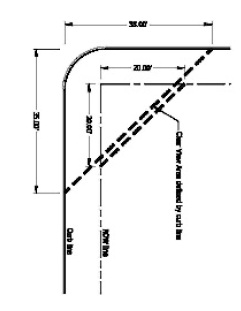(A) Purpose. A fence shall be defined as any partition, structure, wall, or gate erected to serve as a dividing marker, enclosure, physical barrier, or visual barrier.
(B) Materials. All fences built or maintained shall be constructed of materials capable of providing a finished appearance on the outward side visible to the public. All materials used to construct the fence shall be sound materials, resistant to rot, and capable of accepting and maintaining a visually attractive appearance. Fences shall be constructed of the following materials:
(1) Wood;
(2) Simulated wood;
(3) Chain link;
(4) Decorative brick or stone;
(5) Wrought iron or aluminum designed to simulate wrought iron;
(6) Split rail;
(7) Vinyl; or
(8) Other materials or fence types as approved by the Planning Commission.
(C) Location and height in residential districts. In residential districts, fences may be constructed up to a height of 3 1/2 feet and placed anywhere on a lot including the front yard following traffic visibility requirements in division (D) of this section. Any fence over 3 1/2 feet and up to a maximum of 6 feet in height may be located on the rear property line and side property lines, as long as it meets the requirements of division (F) of this section, but may not extend beyond the front most portion of the building line adjacent to the side property line, or closer than 35 feet from the curb or edge of paved or improved portion of the street, whichever is greater. Where a property line is not clearly defined, a certificate of survey shall be required to establish the location of the property line.
(D) On a corner lot, no fence or landscaping shall be placed in such a manner so as to pose a danger to traffic by obscuring the view of approaching vehicular traffic or pedestrians from any driveway or street right-of-way. No fence, structure or planting shall be permitted above a height of 3 feet, measured from where both street centerlines intersect within the triangle described as beginning at the intersection of the projected curb line, or edge of paved portion of roadway if no curbs exist, of 2 intersecting streets, thence 35 feet along one curb line, or edge of paved portion of roadway if no curbs exist, thence diagonally to a point 35 feet from the point of beginning along the other curb line. These requirements shall not apply to conditions of this chapter that legally existed prior to June 14, 2011, unless the Zoning Administrator determines that such conditions constitute a safety hazard.

(E) Location and height in non-residential districts, including commercial, industrial, agricultural, park and open space. Except as set forth below, in non-residential districts, fences may be located on the property line and may be constructed up to a height of 6 feet. If the fence includes a security arm for barbed wire, the maximum height, including the security arm for barbed wire, may be 8 feet tall. Fences allowed in conjunction with alternative energy systems, pursuant to § 153.034, may be constructed up to a height of 8 feet. The city will require compliance with the requirements of division (C) of this section for fences constructed on or near a property line, and one that adjoins a residential district.
(F) Fences of appropriate height for athletic fields are allowed in the park district as determined by sanctioning athletic association regulations and approved by the Planning Commission.
(G) Placement of fences along property lines. Fences may be located upon the division line of the respective properties based on the following:
(1) Where a property line is not clearly defined, a certificate of survey shall be required to establish the location of the property line;
(2) Fences shall be located at least 2 feet from the lot lines; unless when located along the property line the abutting property owners written consent is obtained, and provided no physical damage of any kind results to abutting property; and
(3) Fences shall not restrict drainage. A solid wall style fence may exceed its allowable height by 4 inches to facilitate drainage.
(H) Maintenance. The owner of the property on which a fence is located shall maintain both sides of the fence. Every fence shall be maintained in a condition of reasonable repair and shall not by reason of age, decay, accident or otherwise be allowed to become and remain in a state of disrepair. Should the fence become a nuisance, the owner shall be subject to all legal remedies allowable.
(I) Permits. No person, firm, or corporation shall hereafter construct or cause to be constructed or erected within the city any fence without first securing a fence permit from the City Clerk. The applicant shall certify that the fence will meet all requirements of the city code relating to the height, placement, and type of material. The applicant shall also certify that in the event of any improper placement of the fence the applicant shall relocate the fence within 1 week from notice thereof by the city. Any cost incurred for the relocation shall be the sole responsibility of the applicant.
(J) Agriculture uses. Fences located on property zoned agriculture, at least 10 acres in size, and actively and primarily used for agricultural purposes are not subject to the requirements of this section.
(Ord. 2011-6-4, passed 6-14-2011; Am. Ord. 2013-9-2, passed 9-10-2013; Am. Ord. 2016-4-1, passed 4-12-2016; Am. Ord. 2016-5-6, passed 5-24-2016)